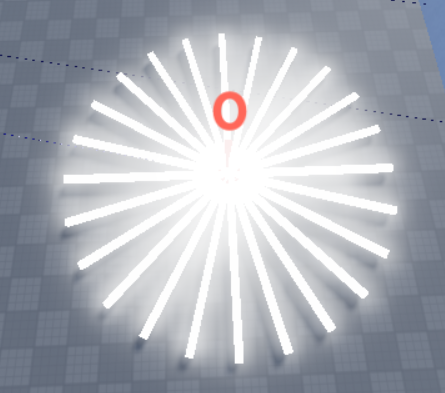Hi, thanks for the reply. The agents have 15 inputs. The first 12 are little lines that detect things such as bullets or the enemy. Here is an image to demonstrate what I mean:

The last 3 inputs are:
CanShoot - Tells the AI whether it can shoot or not
DifInX - The difference in “X” or really just a standardized absolute value difference in the Z axis.
DifInY - Difference in “Y” or again a standardized absolute value difference in the “X” axis.
What do your weights, which you’re training, represent in this model?
I’m not sure exactly what you mean by this question. Each agent uses a neural network, so the weights are essentially just neurons part of the neural network. Some clarification would help.
Also, I have tried other values for my fitness function. I tried encouraging the AIs to shoot by giving them a small reward when they shot a bullet, but that caused spam-like shooting behavior. My original fitness function was purely based off of points scored, or AKA bullets landed on the enemy. My latest idea was to penalize the agents for each movement to hopefully encourage them to take more efficient movements and discourage spinning in circles and spam shooting bullets. Also, sorry for not providing code earlier. This code might be quite a bit but here it is:
script.Parent.AlignPosition.Position = Vector3.new(script.Parent.Position.X,0.5,script.Parent.Position.Z)
local SS = game:GetService('ServerStorage')
local LastShot = nil
local MovementSpeed = 2.5
local TurnSpeed = 5
local function MoveForward(Amount)
script.Parent.AlignPosition.Position += Vector3.new(script.Parent.CFrame.LookVector.X,0,script.Parent.CFrame.LookVector.Z) * Amount
end
local function MoveBackward(Amount)
script.Parent.AlignPosition.Position -= script.Parent.CFrame.LookVector * Amount
end
local function TurnLeft(Amount)
script.Parent.AlignOrientation.CFrame = CFrame.Angles(0,math.rad(script.Parent.Orientation.Y + Amount),math.rad(-90))
end
local function TurnRight(Amount)
script.Parent.AlignOrientation.CFrame = CFrame.Angles(0,math.rad(script.Parent.Orientation.Y - Amount),math.rad(-90))
end
local function Shoot()
LastShot = os.clock()
local Clone = SS.RedBullet:Clone()
Clone.CFrame = script.Parent.CFrame + script.Parent.CFrame.LookVector * 4
Clone.Parent = workspace
coroutine.wrap(function()
--script.Parent.BillboardGui.Score.Text = tostring(script.Parent.BillboardGui.Score.Text + 0.1)
repeat
if Clone.Parent == nil or Clone == nil then break end
local TouchingParts = workspace:GetPartsInPart(Clone,OverlapParams.new())
for i,v in pairs(TouchingParts) do
if v.Parent.Name == 'Blue' then
Clone:Destroy()
script.Parent.Parent.Parent.Blue.Head.BillboardGui.Score.Text = tostring(script.Parent.Parent.Parent.Blue.Head.BillboardGui.Score.Text - 3)
script.Parent.BillboardGui.Score.Text = tostring(script.Parent.BillboardGui.Score.Text + 3)
end
end
task.wait()
until Clone.Parent == nil or Clone == nil
end)()
end
local function UpdateInputs()
local RetTable = {}
for i = 1,#script.Parent.Parent.Inputs:GetChildren() do
local SelectedPart = script.Parent.Parent.Inputs[tostring(i)]
local TouchingParts = workspace:GetPartsInPart(SelectedPart,OverlapParams.new())
for _,part in pairs(TouchingParts) do
if part.Name == 'BlueBullet' then
table.insert(RetTable,-1)
break
elseif part.Parent.Name == 'Blue' then
table.insert(RetTable,-3)
break
else
table.insert(RetTable,0)
break
end
end
end
if LastShot == nil or os.clock() - LastShot >= 0.25 then
table.insert(RetTable,1)
else
table.insert(RetTable,0)
end
local DifInX = math.abs(script.Parent.Position.Z - script.Parent.Parent.Parent.Blue.Head.Position.Z)
local DifInY = math.abs(script.Parent.Position.X - script.Parent.Parent.Parent.Blue.Head.Position.X)
DifInX = (DifInX - 30) / 30
DifInY = (DifInY - 30) / 30
table.insert(RetTable,DifInX)
table.insert(RetTable,DifInY)
return RetTable
end
local function Sigmoid(x)
return 1 / (1 + math.exp(-x))
end
local function Tanh(x)
return (math.exp(x) - math.exp(-x)) / (math.exp(x) + math.exp(-x))
end
local function Relu(x)
if x > 0 then
return x
else
return 0
end
end
local NumberofInputs = 15
local NumberofHiddenNodes = NumberofInputs + 2
local NumberofOutputNodes = 3
local Rand = Random.new()
local RandomStart = true
local Individuals = {}
local Fitnesses = {}
local Weights = {}
local Stop = script.Parent.Parent.Parent.Stop
local Winner = script.Parent.Parent.Parent.Winner
-- REMEMBER TO INCLUDE BIASES, NOT JUST WEIGHTS
local function RandomizeWeightsBiases()
Weights = {
['In-Hidden1'] = {},
['Hid1-Hidden2'] = {},
['Hid2-Output'] = {}
}
for i = 1,NumberofInputs * NumberofHiddenNodes + NumberofHiddenNodes do
table.insert(Weights['In-Hidden1'],Rand:NextNumber(-3,3))
end
for i = 1,NumberofHiddenNodes * NumberofHiddenNodes + NumberofHiddenNodes do
table.insert(Weights['Hid1-Hidden2'],Rand:NextNumber(-3,3))
end
for i = 1,NumberofHiddenNodes * NumberofOutputNodes + NumberofOutputNodes do
table.insert(Weights['Hid2-Output'],Rand:NextNumber(-3,3))
end
end
script.Parent.Parent.ChangeWeightsAndBiases.Event:Connect(function(WeightsBiases)
if not WeightsBiases then
RandomizeWeightsBiases()
else
Weights = WeightsBiases
end
end)
script.Parent.Parent.RequestWeightsAndBiases.OnInvoke = function()
return Weights
end
script.Parent.Parent.Parent.StartSimulation.Event:Connect(function(WeightsBiases)
repeat
local Inputs = UpdateInputs()
local InHid1 = Weights['In-Hidden1']
local Counter = 1
local HidLay1Vals = {}
local WS = 0
for i,v in pairs(InHid1) do
if Counter < NumberofInputs + 1 then
WS += Inputs[Counter] * v
else
WS += v
Counter = 0
WS = Relu(WS)
table.insert(HidLay1Vals,WS)
WS = 0
end
Counter += 1
end
local Hid1Hid2 = Weights['Hid1-Hidden2']
Counter = 1
local HidLay2Vals = {}
WS = 0
for i,v in pairs(Hid1Hid2) do
if Counter < NumberofHiddenNodes + 1 then
WS += HidLay1Vals[Counter] * v
else
WS += v
Counter = 0
WS = Relu(WS)
table.insert(HidLay2Vals,WS)
WS = 0
end
Counter += 1
end
local Hid2Output = Weights['Hid2-Output']
Counter = 1
local RawOutputVals = {}
WS = 0
for i,v in pairs(Hid2Output) do
if Counter < NumberofHiddenNodes + 1 then
WS += HidLay2Vals[Counter] * v
else
WS += v
Counter = 0
table.insert(RawOutputVals,WS)
WS = 0
end
Counter += 1
end
for i,v in pairs(RawOutputVals) do
RawOutputVals[i] = v / 12
end
local RefinedOutputVals = {}
local FinalOutputs = {}
table.insert(RefinedOutputVals,Tanh(RawOutputVals[1]))
table.insert(RefinedOutputVals,Tanh(RawOutputVals[2]))
table.insert(RefinedOutputVals,Sigmoid(RawOutputVals[3]))
table.insert(FinalOutputs,math.round(RefinedOutputVals[1]))
table.insert(FinalOutputs,math.round(RefinedOutputVals[2]))
table.insert(FinalOutputs,math.round(RefinedOutputVals[3]))
MoveForward(FinalOutputs[1] * MovementSpeed)
TurnRight(FinalOutputs[2] * TurnSpeed)
if FinalOutputs[3] == 1 then
if LastShot == nil or os.clock() - LastShot >= 0.25 then
Shoot()
end
end
task.wait()
until Stop.Value == true
end)
(Code for Red AI, the code for the Blue AI is essentially the same, with just names switched)


